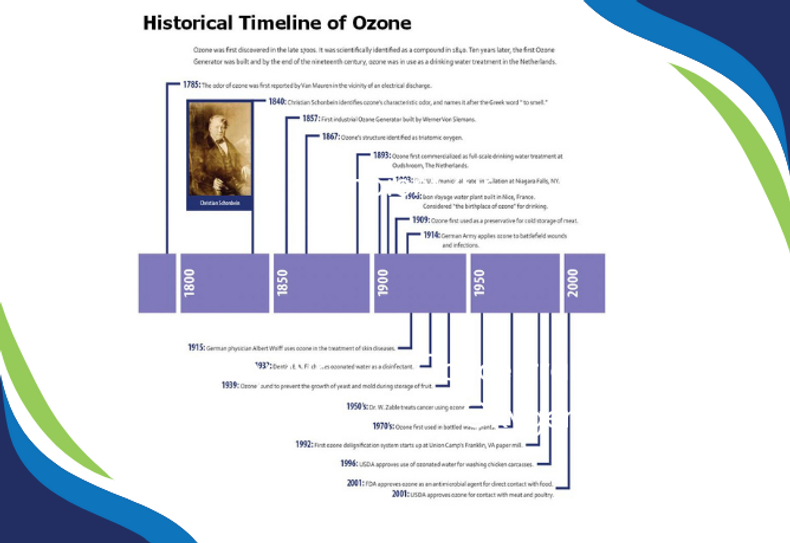|
Date
|
Event
|
|
1785
|
The odor of ozone was first reported by Van Mauren in the vicinity of an electrical discharge
|
|
1840
|
Christian Schonbein identifies ozone's characteristic odor and names it after the Greek word "to smell"
|
|
1857
|
First industrial ozone generator built by Werner Von Slemans
|
|
1867
|
Ozone's structure identified as triatomic oxygen
|
|
1893
|
Ozone first commercialized as a full-scale drinking water treatment at Oudschroom, The Netherlands
|
|
1903
|
First U.S. municipal water installation at Niagara Falls, New York
|
|
1906
|
Bon Voyage water plant built in Nice, France - considered "the birthplace of ozone" for drinking water
|
|
1909
|
Ozone first used as a preservative for cold storage of meat
|
|
1914
|
German Army applies ozone to battlefield wounds and infections
|
|
1915
|
German physician, Albert Wolff, uses ozone in the treatment of skin diseases
|
|
1932
|
Dentist, E.A. Fisch uses ozonated water as a disinfectant
|
|
1939
|
Ozone found to prevent the growth of yeast and mold during storage of fruit
|
|
1950's
|
Dr. W. Zable treats cancer using ozone
|
|
1970's
|
Ozone first used in bottled water plants
|
|
1982
|
FDA GRAS declaration for ozone use in bottled water (Federal Register, Vol. 47, No. 113, November 5, 1982)
|
|
1992
|
First ozone delignification system starts up at Union Camp's Franklin, Virginia paper mill
|
|
1995
|
FDA GRAS for ozone use in bottled water renewed without change
|
|
1996
|
USDA approves the use of ozonated water for washing chicken carcasses
|
|
1997
|
Industry Expert Panel declares ozone GRAS and meets FDA requirements - regulators have the option to later add control on ozone use - Expert Panel Report: Evaluation of the history and safety of ozone in processing foods for human consumption [Vol. 2: Abstracts. Electric Power Research Institute, Palo Alto, California. R&D Enterprise, Inc. / GRAS self declaration (Federal Register, v. 62 #74, April 19,1997)]
|
|
1999
|
USDA rejects an ozone use protocol for meats, cites 1982 GRAS declaration for water where FDA stated "any other use must be regulated by a Food Additive Petition"
|
|
2000
|
Food Additive Petition addresses both water and air use of ozone, under preparation - FDA estimates approval will occur within six months of submission of the Petition
|
|
2000
|
FDA and USDA approval granted
|
|
2000-2004
|
EPA Disinfection By-Products Rules (DBPR) Implementation Stage
|
|
2001
|
FDA approves ozone as an antimicrobial agent for direct contact with food
|
|
2001
|
USDA approves ozone for contact with meat and poultry
|
|
2004
|
Ozone is EPA listed as DBPR compliant
|


